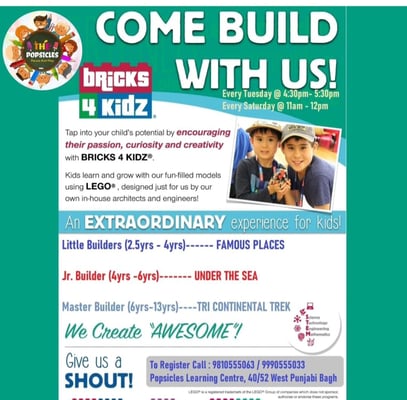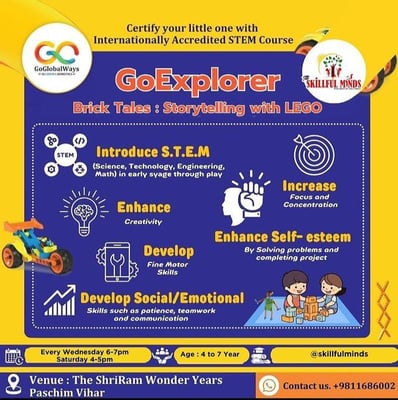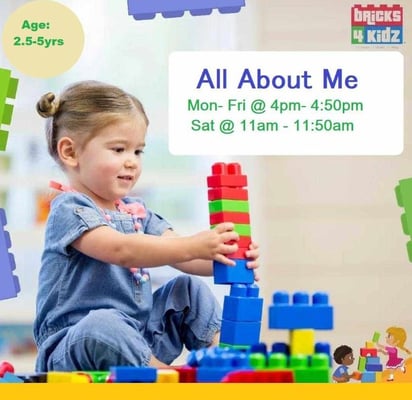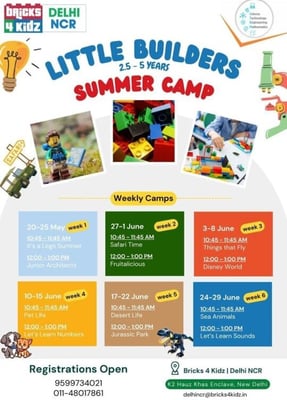Lego classes for Kids - 13 options found
Lego classes for children aged 2 to 15 offer numerous benefi... Lego classes for children aged 2 to 15 offer numerous benefits, including cognitive development, creativity, collaboration, persistence, STEM learning, and social skills development. Through hands-on building activities, children enhance spatial awareness, problem-solving skills, and fine motor skills. Lego classes foster imagination and communication, encourage teamwork, and instill a growth mindset. These classes provide a fun and educational environment where children can explore engineering principles, coding concepts, and storytelling. Participation in Lego classes can lay the foundation for future career opportunities and academic success, preparing children for the challenges of the modern world. Read more
the learning brush-summer lego classes
the learning brush-lego class
bricks4 kidz-summer camps
bricks4 kidz-european tour
the learning brush-summer camp
after school gurus-summer camp
the popsicles-come build with us
skillful minds-brick tales-storytelling with lego
bricks4 kidz-lego themed classes
bricks4 kidz-all about me
bricks4 kidz-little builders summer camp
Advantages of Lego Classes for Children Ages 2 to 15
Lego classes offer children aged 2 to 15 a unique and hands-on learning experience that promotes creativity, problem-solving, and collaboration. In this comprehensive guide, we'll explore the advantages of Lego classes for children in this age range, potential limitations, and address common questions regarding its impact on brain development, personality development, and future career opportunities.
Introduction
Lego classes provide children with the opportunity to engage in constructive play using Lego bricks, sets, and other educational materials. These classes are designed to enhance children's cognitive skills, foster creativity, and promote social interaction through collaborative building activities.
Advantages
-
Cognitive Development:
- Spatial Awareness: Building with Lego bricks enhances children's spatial awareness as they manipulate and assemble three-dimensional structures.
- Problem-Solving Skills: Lego classes encourage children to solve problems and overcome challenges by planning, experimenting, and iterating their designs.
- Fine Motor Skills: Handling small Lego pieces and connecting them together improves children's fine motor skills and hand-eye coordination.
-
Creativity and Imagination:
- Open-Ended Play: Lego classes promote open-ended play, allowing children to unleash their creativity and imagination by building anything they can envision.
- Storytelling: Children often incorporate storytelling into their Lego creations, developing narrative skills and expanding their storytelling abilities.
-
Collaboration and Communication:
- Teamwork: Lego classes often involve collaborative building projects where children work together to achieve a common goal, fostering teamwork and cooperation.
- Communication Skills: Children practice verbal and non-verbal communication as they discuss ideas, share resources, and negotiate roles within their group.
-
Persistence and Resilience:
- Trial and Error: Building with Lego bricks teaches children the value of persistence and resilience as they encounter setbacks and learn from their mistakes through trial and error.
- Embracing Challenges: Children develop a growth mindset by embracing challenges and viewing failures as opportunities for learning and improvement.
-
STEM Learning:
- Engineering Principles: Lego classes introduce children to basic engineering principles such as structural stability, balance, and symmetry through hands-on building activities.
- Coding and Robotics: Advanced Lego sets incorporate coding and robotics elements, providing children with an introduction to programming concepts in a fun and accessible way.
-
Social Skills Development:
- Empathy and Cooperation: Collaborative building projects in Lego classes encourage empathy, cooperation, and respect for others' ideas and perspectives.
- Conflict Resolution: Children learn to navigate conflicts and resolve disagreements constructively as they work together towards a common goal.
Limitations
-
Cost and Accessibility:
- Financial Barrier: Enrolling in Lego classes may be cost-prohibitive for some families, limiting access to this form of enrichment activity.
- Availability: Lego classes may not be readily available in all communities, particularly in rural or underserved areas, limiting access for some children.
-
Safety Concerns:
- Choking Hazard: Small Lego pieces pose a choking hazard for young children, necessitating supervision and age-appropriate sets.
- Injury Risk: Children may accidentally step on or trip over Lego bricks, leading to minor injuries such as cuts or bruises.
Common Questions
-
Are Lego Classes Educational?
- Yes, Lego classes are highly educational as they promote cognitive development, creativity, problem-solving skills, and social interaction through hands-on building activities.
-
Can Lego Classes Lead to Career Opportunities?
- Yes, participation in Lego classes can lay the foundation for future career opportunities in fields such as engineering, architecture, design, and robotics, where creativity, problem-solving, and spatial reasoning skills are valued.
-
What Age Group Benefits Most from Lego Classes?
- Lego classes are beneficial for children of all ages, but younger children (ages 2 to 6) may benefit more from basic building activities that focus on fine motor skills and creativity, while older children (ages 7 to 15) can engage in more complex projects that integrate STEM concepts and coding.
-
How Can Parents Support Learning from Lego Classes at Home?
- Parents can support learning from Lego classes at home by providing access to a variety of Lego sets and encouraging open-ended play, problem-solving, and collaboration among siblings or friends.
Conclusion
Lego classes offer numerous advantages for children aged 2 to 15, including cognitive development, creativity and imagination, collaboration and communication skills, persistence and resilience, STEM learning, and social skills development. While there may be limitations related to cost, accessibility, and safety concerns, the overall benefits of Lego classes are significant. By providing children with hands-on learning experiences that are both fun and educational, Lego classes play a valuable role in their cognitive, social, and emotional development, laying the foundation for future success in various academic and professional pursuits.













